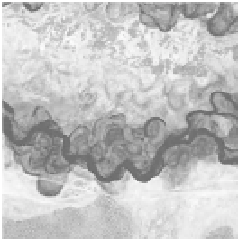Geology Reference
In-Depth Information
8
Holocene deformation
and landscape responses
The record of the most recent 11 000-12 000
years is, on average, considerably more complete
than in any interval of similar duration in
the past. Even compared with the Pleistocene,
we know more during the Holocene about when
specific faults ruptured and how much slip
occurred in each event, we have much more
detail about the tempo and magnitude of climate
change, and we have better temporal control on
diverse processes, such as rates of erosion, the
strength of the monsoon, or earthquake-induced
sediment pulses. Better than any time in the
geological past, the Holocene allows us to
examine interactions, cause and effect, and
positive and negative feedbacks. Hence,
Holocene studies provide a unique opportunity
for tectonic geomorphologists to gain robust
insights on how various parts of the geomorphic
system work and interact. It is important to
remember that specific rates and processes
in the Holocene (especially the late Holocene)
are unlikely to characterize many previous
Quaternary intervals: sea level has been quite
steady for the past 7000 years; the Asian
monsoon is weak; glaciers are highly retracted
during the current interglaciation; and human
society is having an unprecedented impact on
the Earth's surface and atmosphere. Despite
such differences that impede use of the Holocene
as a modern analog for most of the Quaternary,
the quantitative understanding that can be
gained on interacting processes during the
Holocene can be aptly applied to the same
processes in the Quaternary. Thus, knowledge
of how sediment fluxes change in response to
increased precipitation, vegetation changes,
seismic activity, or glacial flow rates provides an
invaluable foundation for assessing impacts of
changes in these variables in the past. Similarly,
in an effort to understand how landscapes
evolve, we can study Holocene
transients
(intervals of change from one state to another)
that enable us to measure many of the relevant
variables. Consider, for example, a modern river
whose channel profile has been offset by a large
earthquake or that has been abruptly diverted
by a landslide. In either case, the river probably
has to begin incising a new channel into solid
bedrock. Given our ability to measure discharge,
channel slope, channel cross-sections, sediment
loads, rock strength, and differential bedrock
incision, measurements of these variables and
the temporal evolution of the channel can
provide insights on the controls, rates, and
interactions of incision processes that would be
impossible to glean in past geological intervals.
Although paleoseismic studies tend to focus
on the intense deformation expressed in rather
narrow fault zones, interferometric geodetic
data (Fig. 5.17) clearly demonstrate that large
earthquakes can cause significant displacement
more than 100 km away from a fault. Geomorphic
responses at Holocene time scales to such
regional deformation, as well as to localized































